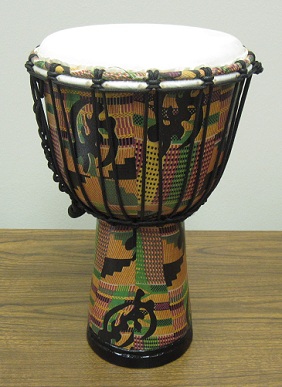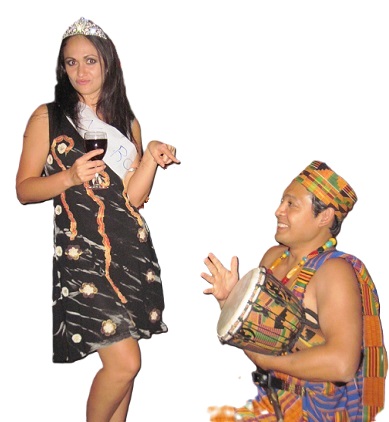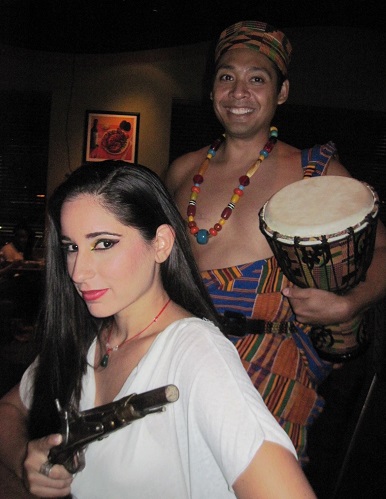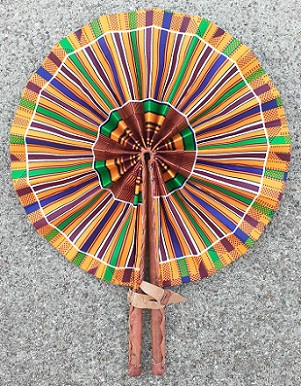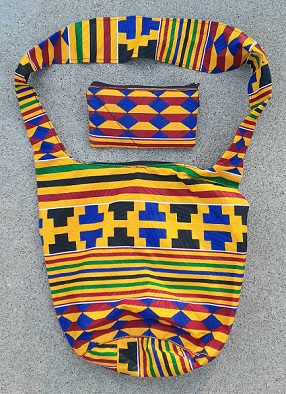Subject: noble warrior
Culture: Asante/Ashanti
Setting: Asante empire, west Africa 1806-1902
Evolution:
Context (Event Photos, Primary Sources, Secondary Sources, Field Notes)
* Knight/Scollins 1989 p10-11
"Of all the peoples in the northern half of Africa whom the British fought in the 19th century, the Asante (pronounced Ashanti), who lived in the great rain forests of present-day Ghana in West Africa, remained the most intractable enemy, maintaining their resistance to European encroachment for over a hundred years.
* Vandervort 1998 p85
"In 1823, following a breakdown in relations with British officials at Cape Coast Castle, the largest British post in the region, an Ashanti army had descended toward the coast to enforce its claims. An army comprised of warriors of the Fante people, who were local British allies, and a small detachment of British troops under the command of the Governor of Sierra Leone, General Sir Charles McCarthy, had sallied forth to meet them in January 1824. The allied force, outnumbered and outflanked, had fled in disarray, leaving the governor to be killed and beheaded by the victorious Ashantis. McCarthy's skull, whose fate would become something of an obsession with two generations of British statesmen and soldiers, was carried off to the Ashanti capital, where it became a highlight of the annual Yam Festival. Forty years later, by which time the British government had declared a protectorate over the land in the proximity of its trading posts on the Gold Coast, another British-led army had advanced against the Ashantis, only to be caught in the rainy season and forced to withdraw when disease put half of its troops out of action.
Costume (Batakari, Kente, Bag)
* Knight/Scollins 1989 p14
"The standard dress for male Asante was a large oblong of brightly woven or printed cloth, wrapped around the waist and thrown over the left shoulder rather like the Roman toga. Since this restricted the movement of the left arm, it was usually just wrapped around the waist in time of war, and sometimes gathered up to leave the legs free below the knees. A distinctive item worn by senior Asante commanders was a war-smock, called batakari. These reflected the influence of Moslem societies to the north, since they were completely covered with magical talismans said to protect the wearer against harm. Each talisman was encased in a small brightly coloured square of leather or cloth which was then sewn to the smock.
Musket
* Spring 1993 p59-60
"Firearms were obviously used by the indigenous people of the Guinea Coast from an early date. DeMarees relates that 'They also buy many Firelocks and are beginning to learn to handle them very well'. Each Asante musketman was equipped with a leather cartridge belt, ntoa, which included all the accessories required for war: a calabash powderhorn, dauka, a pouch for shot and flints, a series of small wooden containers, totoa, each containing the powder required for one round, and a set of knives, sepo, the exact function of which remains unclear. It has been suggested that they were used to remove the heads of fallen enemies or to pierce the cheeks of prisoners and thus prevent them from invoking spells and curses against their captors. In view of the small size of the knives, the number (up to ten) carried on any one cartridge belt, and the abiding fear of the enemy's magical potency, the latter explanation seems rather more plausible.
* Knight/Scollins 1989 p13-14
"Theoretically, such guns had a range of 200 yards, but in fact few marksmen could aim with accuracy beyond 30 yards, and the flight of the slug was often erratic. Weather conditions did not help since humidity and sudden downpours could both ruin the powder. Nevertheless, it should not be thought that these drawbacks made the Asante gunmen ineffective: far from it. In the forest where they fought, visibility was strictly limited anyway, and casualties were usually achieved by heavy fire at close quarters, by quantity rather than quality of musketry. British observers were impressed by the dexterity with which the Asante used their firearms: they understood the principle of sights and the necessity of firing from the shoulder -- while many other African groups held guns at arm's length, or fired from the hip to reduce the risk from explosions -- and they were able to perform complex drill, and to fire in a number of postures.
Pistol
* Christoph/Müller/Ritz-Müller 1999 p392-393
"
Sword
* Gold in der Kunst Westafrikas 1975 p10-11
"Wichtige Zeichen der Macht sind bei den kriegerischen Akan-Völkern die Zeremonial-schwerter. Eine bis zu zwei Meter lange, gebogene und oftmals durchbrochene, kunstvoll geschmiedete Eisenklinge steckt in einem hölzernen Griff, den zwei grosse Kugeln begrenzen. Da die Goldschicht auf dem Holz leicht abblättert, werden die Schwerter bei zeremoniellen Auftritten meist an der Klinge gehalten. Diese kann auch in einer Scheide aus Rochenhaut, Leopardenfell oder Antilopenhaut stecken
* Blier 1998 p142-144
"Afena swords were carried by military officers, ambassadors, and messengers representing the ruler on state business as markers of their official status. With their distinctive curving metal blade and gold foil-covered handles of barbell shape, swords had important political functions, among these the making of oaths. In the late seventeenth century, the king of the Denkyira in the south is said to have sent officials carrying such swords to Kumasi when demanding their gold-dust tribute. Local traditions suggest that Asante kings adopted this type of sword after Osei Tutu's victory over the Denkyira. Although it was probably in use here much earlier, this legend is in keeping with other Asante traditions which credit the creation of key art forms to foreigners brought into the Asante confederacy, especially through war.
* Spring 1993 p56
"The afena is fitted with an iron, curved blade, broad at the point but gradually tapering towards a hilt of wood, sometimes encased in gold and consisting of two spheres at either end of a cylindrical grip. The sheath is often fashioned from much-prized ray skin, etwum. However, if this scarce commodity could not be obtained, imitations were sometimes made by painstakingly pitting the surface of antelope leather to simulate the abrasive skin of the ray. The sheath and occasionally the hilt are also decoarted with abosodee, gold castings which show the status of the sword bearer and of his master.
* Christoph/Müller/Ritz-Müller 1999 p402
"Bis zum Ende des 19. Jahrhunderts zählten neben Schemeln und Sänften auch sogenannte Reichsschwerter (afena) zu den Ehrengeschenken, mit denen vor allem Statthalter der Grenzprovinzen ausgezeichnet wurden, um sie zu belohnen und in hireer Loyalität bestärken. Die Zal wie die besonders kunstvolle Ausführung der Stücke unterstreichen Würde und Macht ihrer Besitzer. Ab dem 18. Jahrhundert bis zum Beginn der Kolonialzeit entwickelten sie sich von Kampf- mehr und mehr zu reich mit Golddekor überzogenen Paradewaffen. Vor Einführung der Gewhre gehörten Speer und Schwert (domfena) zur Ausrüstung jedes Kriegers. Mit der fortschreitenden Zentralisierung wurden die Schwerter zu Autoritätszeichen, mit denen der Asantehene verschiedene Würdenträger bedachte. Ihre wesentliche Bedeutung lag jetzt im Ausweis der königlichen Machtdelegation."
Jewelry
*
"
Drum
*
"
Fan
*
"
Bag
*
"
